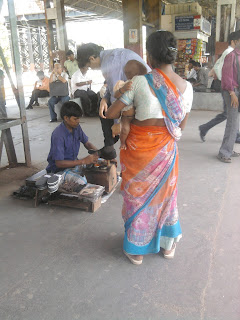This is ridiculous. If institutions start behaving in such irrational way, what should we expect from our to be professionals?
The AOA library installed about 12 new computers in the library and momentarily put a zip on the students voice. The reality is that none of them work, rather are not made functional yet. They are waiting for its "official inauguration". I dont understand what is there to inaugurate in computers, which were supposed to be here long time back. Students are waiting to work and Mr. Important will come some day and inaugurate the silly pcs.
The students fear to write a complaint letter thinking that the management will fire back and take revenge, which might affect their grades. Systems thus become corrupt. In India, they become stale and then stink.
We are crying for additional machines (PCs) to work and the issue has already been postponed for two months now. We have already lost a lot of data in a computer crash.
In our country, the burden of inefficiency in work is put only on the employees. Its normal to hold the employee responsible for slow, or insufficient product. Seldom does anyone take into account the work environment. Such work environments are extremely demoralizing for people who want to work. This mood settles in people and becomes a long term crib.
Half the time is spent in quarreling, writing complaint letters and traveling across hierarchies to reach right people. The verdict is always that you get frustrated and give up. The people who go on extremes of such situations become cynics. The other kind of people are social workers.
I have worked earlier at the Goethe Institute, Mumbai, and I can compare the kind of professionalism in work atmosphere that we have in our scenarios and international ones. Its sad to categorize our context in the negative in this scenario. But India runs like that. There are momentary answers given to shut people's mouths and the solution is just a 'jugaad'. There is not english word for jugaad. Still, people work, people keep up with their jobs - like we do. The employers are shameless, and they dont mind this kind of shame. After all, they believe that they are the people who produce the highest calibre of professionals in the country.
Money drives institutions. Huge amount of money is pocketed. There is no transparency. And unfortunately, it is the facilities that make the institutions run, not the teachers. It is appalling to see the newest of the institutions promote their swimming pools, computer labs, green lawns, wi fi systems and all amenities - NOT one says that we have Good teachers. Parents too judge schools with infrastructure, not teachers. It is not therefore surprising to see that students become demanding of facilities. But my point here is that institutions realize this demand and use it as a marketing gimmick. They extract huge money from entrants, but in the end, do not give facilities to students. What's the point? There have to be ways to fight. There have to be other ways to retaliate, negotiate. I dont know how! Seems the only party in loss is the students and staff. Long live the parasites!
The AOA library installed about 12 new computers in the library and momentarily put a zip on the students voice. The reality is that none of them work, rather are not made functional yet. They are waiting for its "official inauguration". I dont understand what is there to inaugurate in computers, which were supposed to be here long time back. Students are waiting to work and Mr. Important will come some day and inaugurate the silly pcs.
The students fear to write a complaint letter thinking that the management will fire back and take revenge, which might affect their grades. Systems thus become corrupt. In India, they become stale and then stink.
We are crying for additional machines (PCs) to work and the issue has already been postponed for two months now. We have already lost a lot of data in a computer crash.
In our country, the burden of inefficiency in work is put only on the employees. Its normal to hold the employee responsible for slow, or insufficient product. Seldom does anyone take into account the work environment. Such work environments are extremely demoralizing for people who want to work. This mood settles in people and becomes a long term crib.
Half the time is spent in quarreling, writing complaint letters and traveling across hierarchies to reach right people. The verdict is always that you get frustrated and give up. The people who go on extremes of such situations become cynics. The other kind of people are social workers.
I have worked earlier at the Goethe Institute, Mumbai, and I can compare the kind of professionalism in work atmosphere that we have in our scenarios and international ones. Its sad to categorize our context in the negative in this scenario. But India runs like that. There are momentary answers given to shut people's mouths and the solution is just a 'jugaad'. There is not english word for jugaad. Still, people work, people keep up with their jobs - like we do. The employers are shameless, and they dont mind this kind of shame. After all, they believe that they are the people who produce the highest calibre of professionals in the country.
Money drives institutions. Huge amount of money is pocketed. There is no transparency. And unfortunately, it is the facilities that make the institutions run, not the teachers. It is appalling to see the newest of the institutions promote their swimming pools, computer labs, green lawns, wi fi systems and all amenities - NOT one says that we have Good teachers. Parents too judge schools with infrastructure, not teachers. It is not therefore surprising to see that students become demanding of facilities. But my point here is that institutions realize this demand and use it as a marketing gimmick. They extract huge money from entrants, but in the end, do not give facilities to students. What's the point? There have to be ways to fight. There have to be other ways to retaliate, negotiate. I dont know how! Seems the only party in loss is the students and staff. Long live the parasites!



















